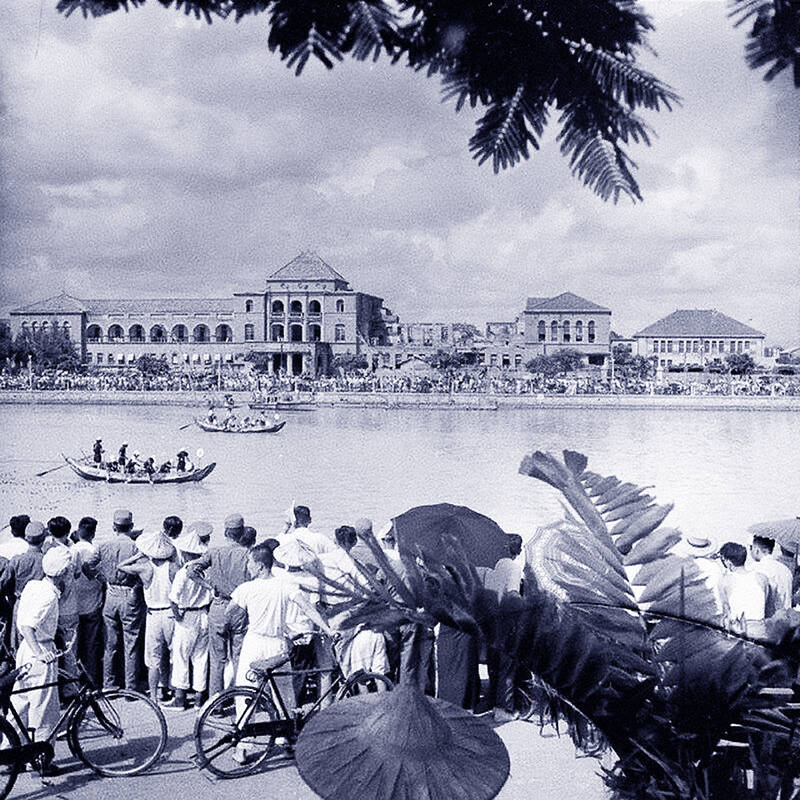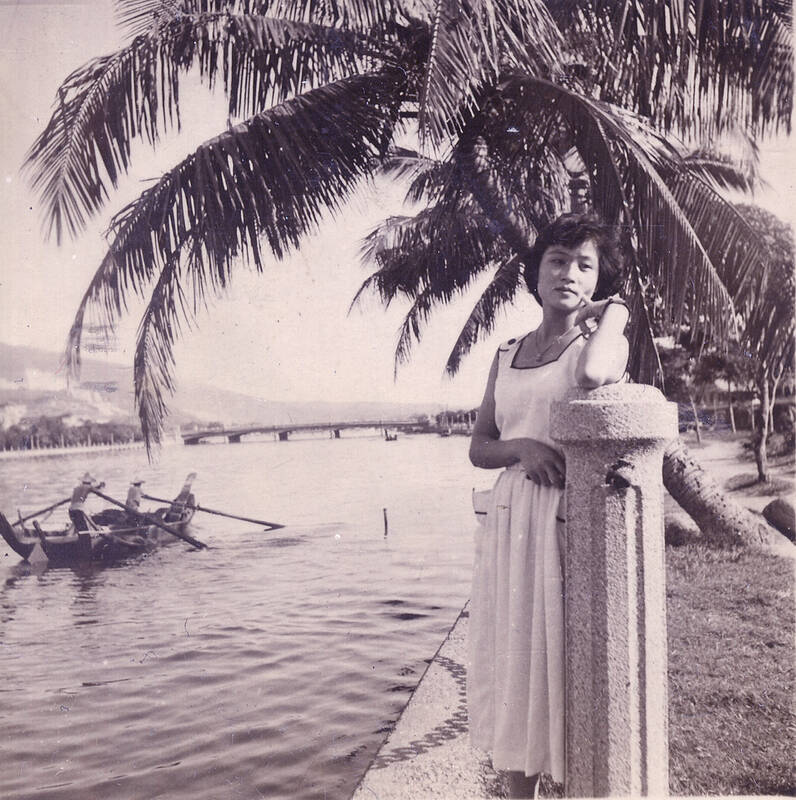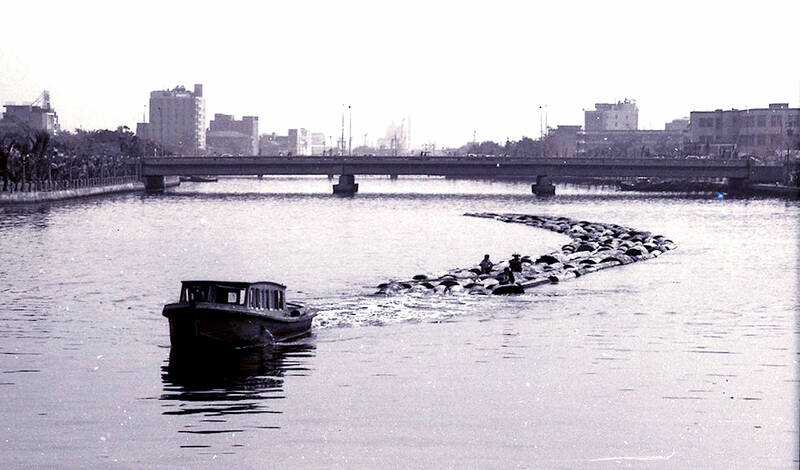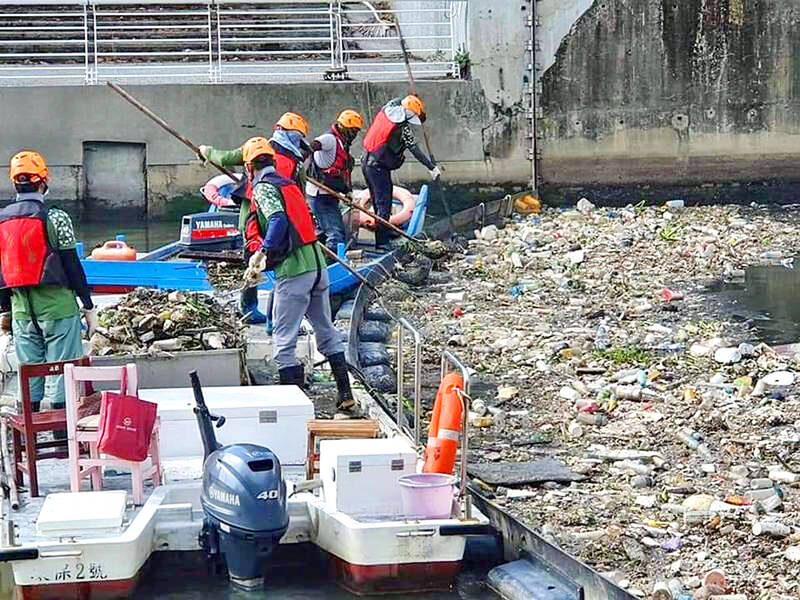July 22 to July 28
The Love River’s (愛河) four-decade run as the host of Kaohsiung’s annual dragon boat races came to an abrupt end in 1971 — the once pristine waterway had become too polluted. The 1970 event was infamous for the putrid stench permeating the air, exacerbated by contestants splashing water and sludge onto the shore and even the onlookers.
The relocation of the festivities officially marked the “death” of the river, whose condition had rapidly deteriorated during the previous decade. The myriad factories upstream were only partly to blame; as Kaohsiung’s population boomed in the 1960s, all household wastewater went directly into the waterway due to poor sewage management.

Photo courtesy of Wikimedia Commons
The government finally began rectifying the problem in 1977. The first phase, which entailed installing mechanisms to intercept wastewater and building separate sewers, took 10 years to complete. In February 1987, Kaohsiung city councilor Chen Tsun-hsiung (陳村雄) jumped into the river during a press conference. After emerging, he told reporters that the water was “sweet,” and after he got home he reportedly found a small crab in his suit pocket.
The dragon boat races returned to the Love River that year, but there was still a lot of work to do. It wasn’t until July 24, 2002 that the government considered the project a success, celebrating by reopening the gate separating the upper and lower parts of the rivers that had been shut off for 16 years. By this time, the Love River had once again become a popular hangout spot, with cruises, riverside parks, coffee shops and other sights.
News reports of dirty water would continue to surface in the ensuing decades, and the government still had to fix the river’s upper reaches — but the worst was over.

Photo courtesy of Kaohsiung City Bureau of Cultural Affairs
RIVER OF LOVE?
For those familiar with local toponymy, “Love River” is an unusual name for a Taiwanese waterway. In fact, it was originally called the Takao River, and later the Kaohsiung River, obtaining its current name by pure accident. Most accounts state that there was a tourist operation along the river named the Love River Cruise (愛河遊船所) during the late 1940s. In 1947, a typhoon blew off the “cruises” part of the sign, and it was never repaired.
The following June, a woman’s corpse was found in the river. It was suspected that she committed suicide due to love problems, as it was common method in those days for forbidden lovers to die (there was even a movie in 1956 about it called The Canal Suicides, 運河殉情記). A reporter who had recently moved to Kaohsiung saw the sign and wrote it into the story’s headline — and somehow, the name stuck. By July 1950, most media outlets, including the state-run Central Daily News (中央日報), were referring to it as “Love River.”

Photo courtesy of Kaohsiung City Bureau of Cultural Affairs
It was renamed Renai River (仁愛河) in 1970, a name that the ruling Chinese Nationalist Party (KMT) favored and gave to numerous locales, but locals continued to use the old name. In 1992, five years after the lifting of martial law, it was once again renamed the Love River.
PUTRID STENCH
Until the 1960s, the river was a pleasant spot for people to relax on the banks or enjoy a boat ride, and commercial activity was also abuzz. But the city was growing fast — from 168,008 people in 1947 to 669,146 in 1967 — as it developed into an industrial behemoth. A large percentage was concentrated along the river.

Photo courtesy of Kaohsiung City Government
After the government in 1947 banned logging in Alishan, timber companies began importing wood from Southeast Asia. Since the goods arrived in Kaohsiung harbor, these businesses built log ponds and processing facilities along the Love River. It was a common sight to see small motorboats dragging hundreds of logs, and this was the beginning of the river’s contamination.
Later, other factories (mostly leather, food processing, paper and chemical) sprung up along the waterway further inland in Gushan (鼓山) and Sanmin (三民) districts.
During the 1930s, the city’s famous dragon boat races, which were originally held by the ocean, were moved to the Love River. According to a China Times (中國時報) article, a particularly spirited team comprised of Marines splattered foul water and mud onto horrified audience members during their performance in 1970, and that was the last straw.
The next year, the races were moved to Lotus Lake (蓮池潭) and the river was declared dead, as only the hardiest creatures could survive in such waters. The China Times article states that back then, whenever passing by the river people could only cover their noses and quicken their pace.
RESUSCITATING THE RIVER
Hu Chin-yin (胡金印) writes in “Shaping the landscape for urban riverside tourism — Kaohsiung’s Love River as an example” (都市河岸觀光景觀之形塑—以高雄市愛河為例) that the first phase of the cleaning process involved setting up 11 wastewater interception stations along the river, especially in the heavily populated lower reaches, beautifying the banks and removing long standing illegal structures, and dredging 380,000m2 of sludge.
By the time Chen jumped into the Love River, there was still no separation of domestic and storm sewage, meaning that wastewater still went directly into the waterway before it was intercepted and diverted to a treatment plant.
The part that Chen submerged himself in was indeed cleaner at that time, but the waters upstream were still quite polluted. During heavy rain, the intercepting gates were opened and the filth still flooded into the downtown section.
The second phase was to upgrade wastewater interception and treatment capabilities, and to continue building and repairing sewage pipes while connecting households to the system. Hu writes that by 1997, 11 percent of the wastewater producing area was directly connected. This number reached 50.1 in 2007.
In 2001, Kaohsiung hosted the Taiwan Lantern Festival, which had been held in Taipei since its inception in 1990. The centerpiece was the “Jumping Turtle, Soaring Dragon” (鰲躍龍翔) installation by the Love River, which remains a landmark today.
The festival was held by the Love River again the following year, and an annual local version has taken place by the riverbank since. Cruises had resumed, and the Love River was once again teeming with activity.
Taiwan in Time, a column about Taiwan’s history that is published every Sunday, spotlights important or interesting events around the nation that either have anniversaries this week or are tied to current events.

Exceptions to the rule are sometimes revealing. For a brief few years, there was an emerging ideological split between the Democratic Progressive Party (DPP) and Chinese Nationalist Party (KMT) that appeared to be pushing the DPP in a direction that would be considered more liberal, and the KMT more conservative. In the previous column, “The KMT-DPP’s bureaucrat-led developmental state” (Dec. 11, page 12), we examined how Taiwan’s democratic system developed, and how both the two main parties largely accepted a similar consensus on how Taiwan should be run domestically and did not split along the left-right lines more familiar in

As I finally slid into the warm embrace of the hot, clifftop pool, it was a serene moment of reflection. The sound of the river reflected off the cave walls, the white of our camping lights reflected off the dark, shimmering surface of the water, and I reflected on how fortunate I was to be here. After all, the beautiful walk through narrow canyons that had brought us here had been inaccessible for five years — and will be again soon. The day had started at the Huisun Forest Area (惠蓀林場), at the end of Nantou County Route 80, north and east

Specialty sandwiches loaded with the contents of an entire charcuterie board, overflowing with sauces, creams and all manner of creative add-ons, is perhaps one of the biggest global food trends of this year. From London to New York, lines form down the block for mortadella, burrata, pistachio and more stuffed between slices of fresh sourdough, rye or focaccia. To try the trend in Taipei, Munchies Mafia is for sure the spot — could this be the best sandwich in town? Carlos from Spain and Sergio from Mexico opened this spot just seven months ago. The two met working in the

This month the government ordered a one-year block of Xiaohongshu (小紅書) or Rednote, a Chinese social media platform with more than 3 million users in Taiwan. The government pointed to widespread fraud activity on the platform, along with cybersecurity failures. Officials said that they had reached out to the company and asked it to change. However, they received no response. The pro-China parties, the Chinese Nationalist Party (KMT) and Taiwan People’s Party (TPP), immediately swung into action, denouncing the ban as an attack on free speech. This “free speech” claim was then echoed by the People’s Republic of China (PRC),